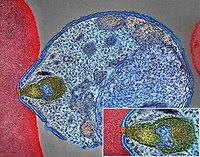
Photo from wikipedia
Background Early and accurate diagnosis of malaria is critical to the success of malaria elimination. However, the current mainstay of malaria diagnosis in the field, such as light microscopy and… Click to show full abstract
Background Early and accurate diagnosis of malaria is critical to the success of malaria elimination. However, the current mainstay of malaria diagnosis in the field, such as light microscopy and rapid diagnostic tests (RDTs), have limitations due to low parasite density or mutation in diagnostic markers. Methods We evaluated an inexpensive, robust, rapid, malaria diagnostic device, called Gazelle, that employs magneto-optical detection to identify haemozoin crystals (Hz) produced by all species of human malaria parasites in infected individuals. A beam of polarised light is passed through the lysed diluted blood sample under the influence of high (~.55T) and low magnetic fields. The difference in light transmission through the sample between the high and low magnetic fields indicates presence of Hz, suggesting possible malarial infection. A total of 300 febrile patients were screened at the malaria clinic of Indian Council of Medical Research-National Institute of Research in Tribal Health (ICMR-NIRTH), Jabalpur, India, from August 2018 to November 2018. Malaria diagnosis was done using four diagnostic methods: Gazelle, light microscopy, RDT, and malaria specific Polymerase Chain Reaction (PCR). Measures of diagnostic accuracy were compared. Findings Out of 300 febrile patients enroled and tested for the presence of malaria parasites, 262 patient samples were included in the final analysis. The sensitivity and specificity of Gazelle was 98% and 97% in comparison to light microscopy, 82% and 99% to PCR and 78% and 99% to RDT, respectively. The results of the four diagnostic methods were comparable and statistically no significant differences in sensitivity or specificity was observed between these methods. Enhanced diagnostic accuracy of Gazelle in malaria patients with no prior history of malaria treatment was observed in this study. Interpretation The diagnostic ability of Gazelle was comparable to light microscopy and better than RDTs even in low parasitemia and in presence of pfhrp2/3 deletion mutant parasites. Gazelle may be a novel valuable diagnostic tool in resource poor settings where (i) microscopy is not feasible and (ii) pfhrp2/3gene deleted parasite are present. Its speed, cost-efficiency, and alternative to lack of microscopists makes it an important adjunct in field settings. Funding HemexDx, India.
Journal Title: EClinicalMedicine
Year Published: 2020
Link to full text (if available)
Share on Social Media: Sign Up to like & get
recommendations!